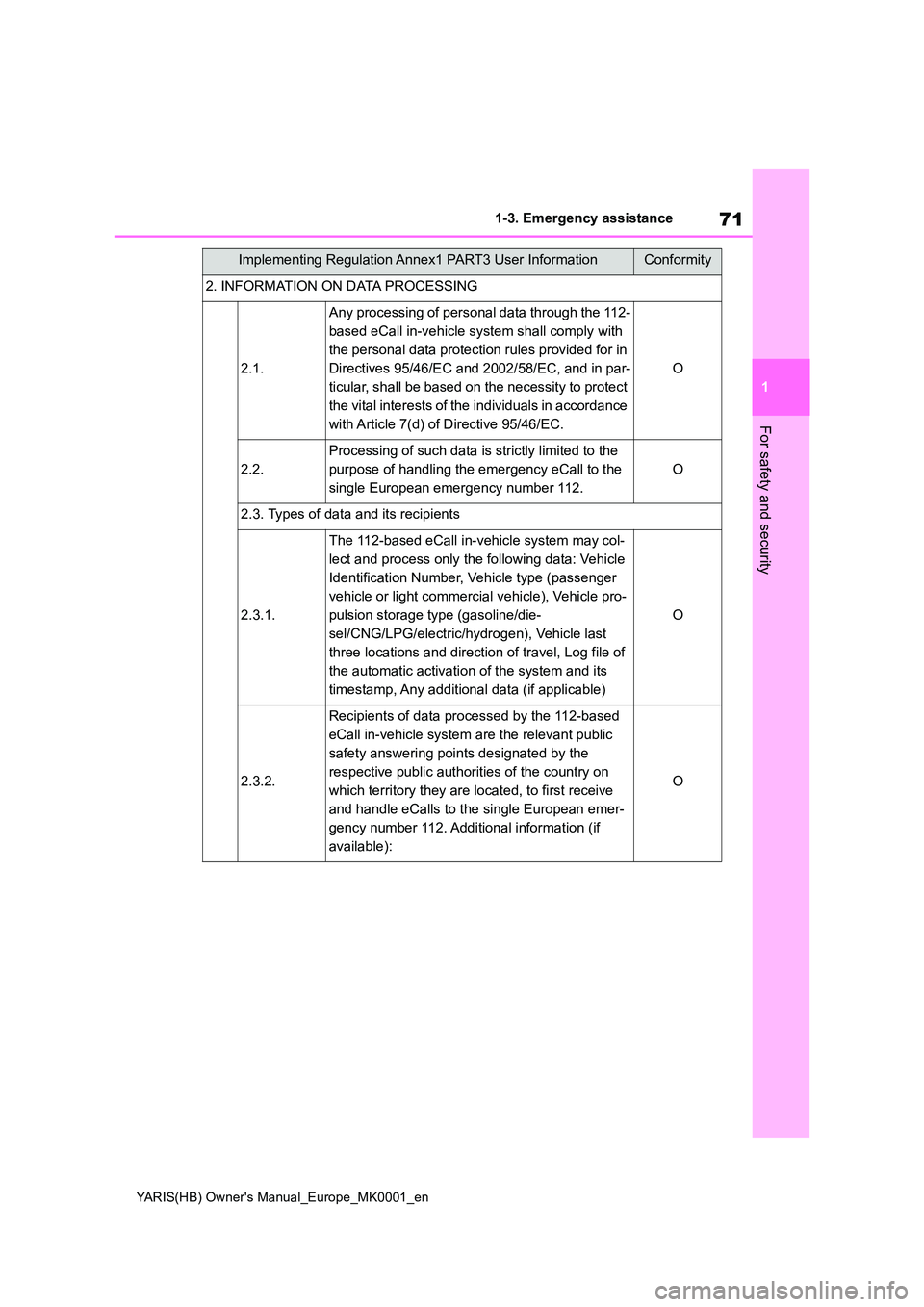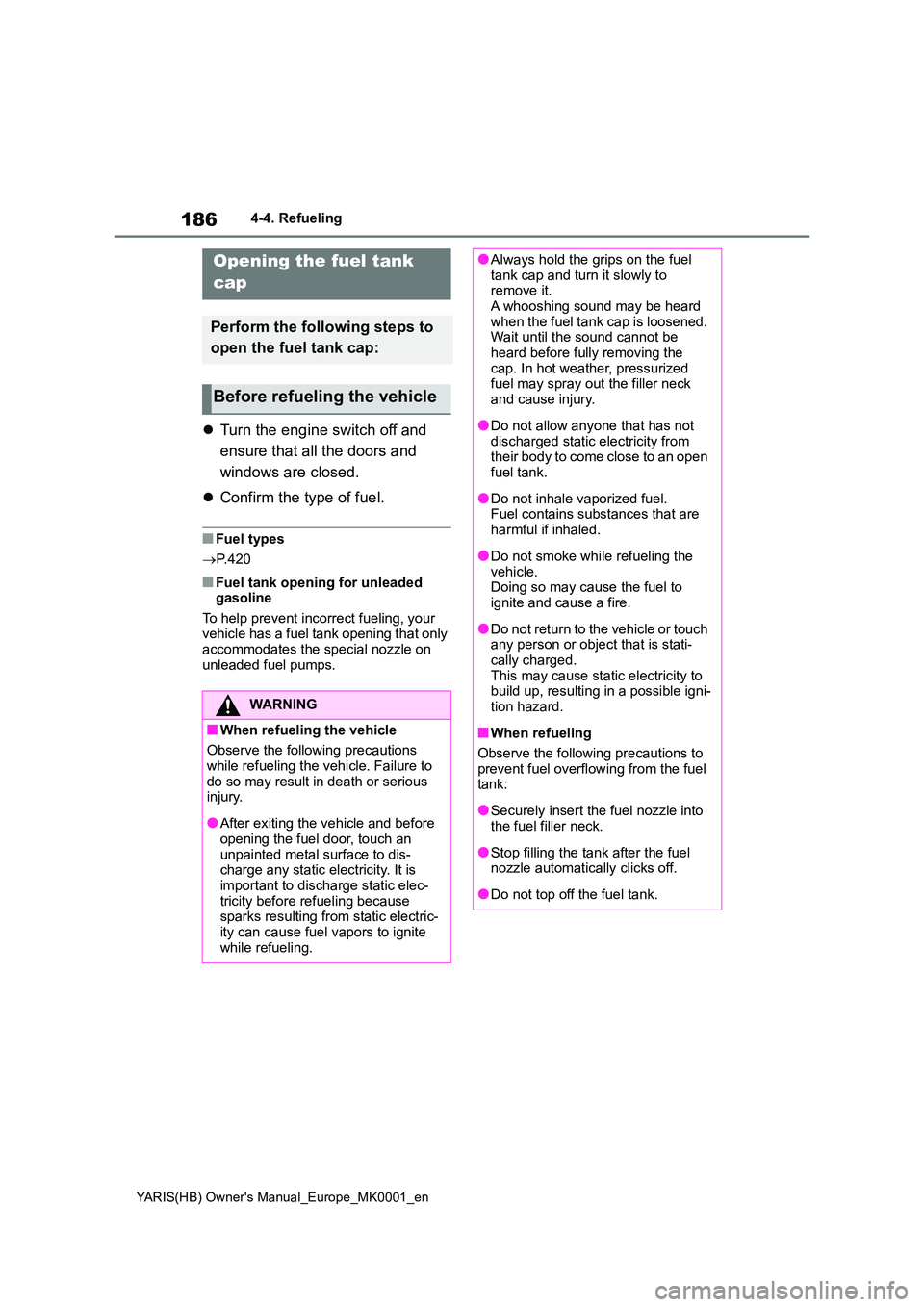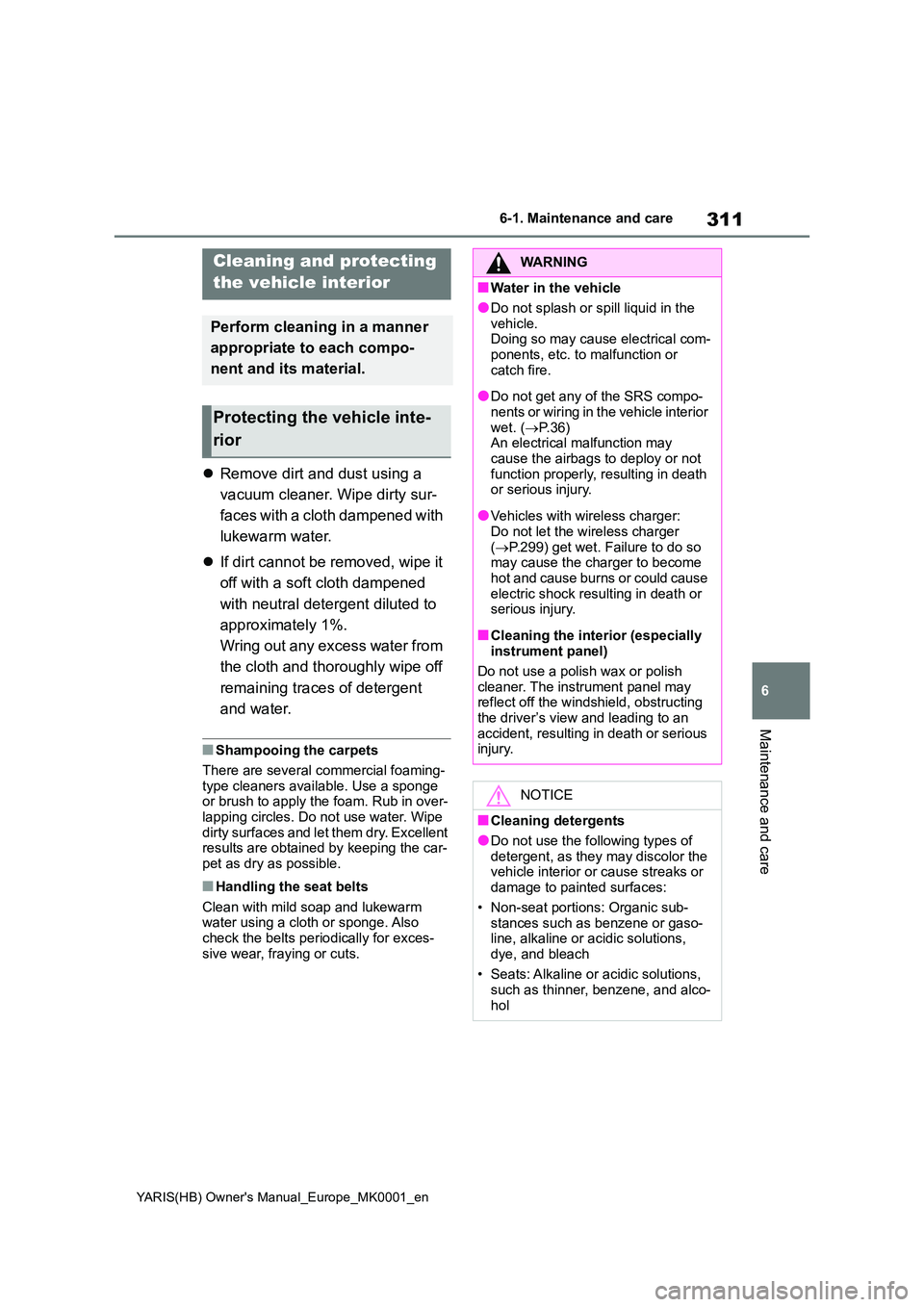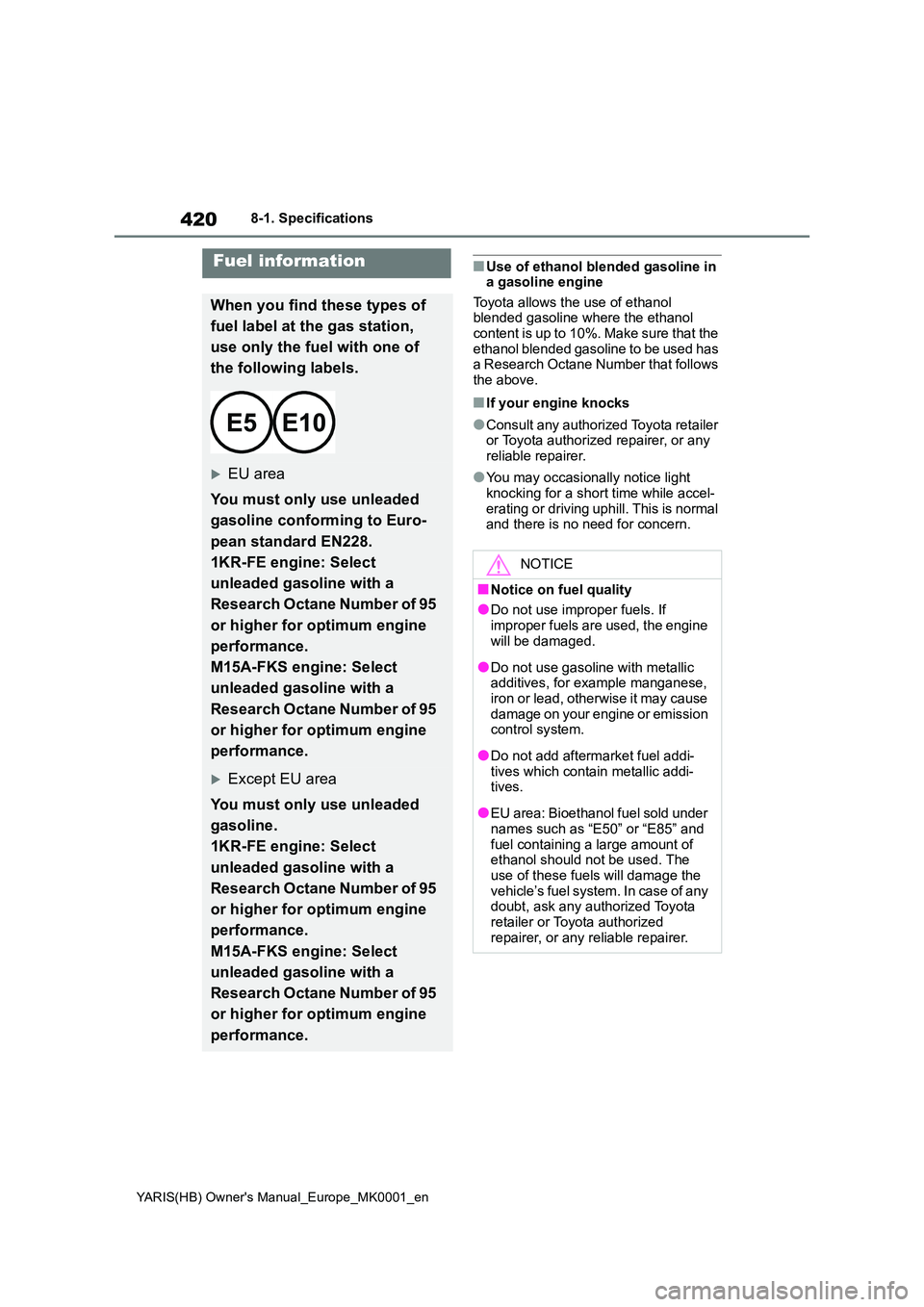2021 TOYOTA YARIS HATCHBACK gas type
[x] Cancel search: gas typePage 38 of 568

38
YARIS(HB) Owner's Manual_Europe_MK0001_en
1-1. For safe use
SRS warning light
Driver airbag
Airbag manual on-off switch
The main SRS airbag system components are shown above. The SRS air-
bag system is controlled by the airbag sensor assembly. As the airbags
deploy, a chemical reaction in the inflators quickly fills the airbags with non-
toxic gas to help restrain the motion of the occupants.
■If the SRS airbags deploy (inflate)
●Slight abrasions, burns, bruising etc., may be sustained from SRS airbags, due to the extremely high speed
deployment (inflation) by hot gases.
●A loud noise and white powder will be emitted.
●Parts of the airbag module (steering wheel hub, airbag cover and inflator) as well as the front seats, parts of the
front and rear pillars, and roof side rails, may be hot for several minutes. The airbag itself may also be hot.
●The windshield may crack.
●The brakes and stop lights will be con-trolled automatically. ( →P.269)
●The interior lights will turn on automat- ically. ( →P.292)
●The emergency flashers will turn on automatically. ( →P.360)
●Fuel supply to the engine will be stopped. ( →P.367)
●Vehicles with eCall: If any of the fol-
lowing situations occur, the system is
designed to send an emergency call*
to the eCall control center, notifying them of the vehicle’s location (without needing to push the “SOS” button)
and an agent will attempt to speak with the occupants to ascertain the level of emergency and assistance
required. If the occupants are unable to communicate, the agent automati-cally treats the call as an emergency
and helps to dispatch the necessary emergency services. ( →P.66)
• An SRS airbag is deployed.
• A seat belt pretensioner is activated. • The vehicle is involved in a severe rear-end collision.*: In some cases, the call cannot be
made. ( →P. 6 7 )
■SRS airbag deployment conditions
(SRS front airbags)
●The SRS front airbags will deploy in
the event of an impact that exceeds the set threshold level (the level of force corresponding to an approxi-
mately 20 - 30 km/h [12 - 18 mph] frontal collision with a fixed wall that does not move or deform).
However, this threshold velocity will be considerably higher in the following situ-
ations: • If the vehicle strikes an object, such as a parked vehicle or sign pole,
which can move or deform on impact • If the vehicle is involved in an under-ride collision, such as a collision in
which the front of the vehicle “under- rides”, or goes under, the bed of a truck
●Depending on the type of collision, it is possible that only the seat belt
pretensioners will activate.
■SRS airbag deployment conditions (SRS side and curtain shield air-bags)
●The SRS side and curtain shield air-bags will deploy in the event of an
impact that exceeds the set threshold level (the level of force corresponding to the impact force produced by an
Page 71 of 568

71
1
YARIS(HB) Owner's Manual_Europe_MK0001_en
1-3. Emergency assistance
For safety and security
2. INFORMATION ON DATA PROCESSING
2.1.
Any processing of personal data through the 112-
based eCall in-vehicle system shall comply with
the personal data protection rules provided for in
Directives 95/46/EC and 2002/58/EC, and in par-
ticular, shall be based on the necessity to protect
the vital interests of the individuals in accordance
with Article 7(d) of Directive 95/46/EC.
O
2.2.
Processing of such data is strictly limited to the
purpose of handling the emergency eCall to the
single European emergency number 112.
O
2.3. Types of data and its recipients
2.3.1.
The 112-based eCall in-vehicle system may col-
lect and process only the following data: Vehicle
Identification Number, Vehicle type (passenger
vehicle or light commercial vehicle), Vehicle pro-
pulsion storage type (gasoline/die-
sel/CNG/LPG/electric/hydrogen), Vehicle last
three locations and direction of travel, Log file of
the automatic activation of the system and its
timestamp, Any additional data (if applicable)
O
2.3.2.
Recipients of data processed by the 112-based
eCall in-vehicle system are the relevant public
safety answering points designated by the
respective public authorities of the country on
which territory they are located, to first receive
and handle eCalls to the single European emer-
gency number 112. Additional information (if
available):
O
Implementing Regulation Annex1 PART3 User InformationConformity
Page 98 of 568

98
YARIS(HB) Owner's Manual_Europe_MK0001_en
2-1. Instrument cluster
start/after reset/after refuel. ( →P.95)
�z (if equipped)
Select to display/not display the audio
system linked display.
�z
Select to change the displayed content
of the following:
• Drive information type
Select to change the drive information
type display between after start/after
reset.
• Drive information items
Select to set the first and second items
of the drive information display to any of
the following: average vehicle
speed/distance/elapsed time.
�z Pop-up display
Select to enable/disable pop-up dis-
plays for each relevant system.
�z Multi-information display off
Select to turn the multi-information dis-
play off.
To turn the multi-information display on
again, press any of the following meter
control switches
//// /.
�z Default setting
Select to reset the meter display set-
tings to the default setting.
■Vehicle functions and settings
that can be changed
→ P. 4 2 2
■Suspension of the settings display
●Some settings cannot be changed while driving. When changing set-
tings, park the vehicle in a safe place.
●If a warning message is displayed, operation of the settings display will
be suspended.
�z Stop & Start system operation
time (after start)/status notifica-
tion
Displays the current amount of time the
engine has been stopped by the opera-
tion of the Stop & Start system.
Also shows the status of the Stop &
Start system with a pop-up display.
( →P.234)
�zStop & Start system settings
The length of time of the Stop & Start
system will operate when the “A/C”
switch of the air conditioning system is
on can be set to 2 different levels in
of the multi-information display.
WARNING
■Cautions during setting up the display
If the engine is running when chang- ing the display settings, ensure that the vehicle is parked in a place with
adequate ventilation. In a closed area such as a garage, exhaust gases including harmful carbon monoxide
(CO) may collect and enter the vehi- cle. This may lead to death or a seri-ous health hazard.
NOTICE
■During setting up the display
To prevent battery discharge, ensure
that the engine is running while set- ting up the display features.
Stop & Start system infor-
mation (if equipped)
Page 186 of 568

186
YARIS(HB) Owner's Manual_Europe_MK0001_en
4-4. Refueling
4-4.Refuelin g
�zTurn the engine switch off and
ensure that all the doors and
windows are closed.
�z Confirm the type of fuel.
■Fuel types
→ P. 4 2 0
■Fuel tank opening for unleaded gasoline
To help prevent incorrect fueling, your vehicle has a fuel tank opening that only accommodates the special nozzle on
unleaded fuel pumps.
Opening the fuel tank
cap
Perform the following steps to
open the fuel tank cap:
Before refueling the vehicle
WARNING
■When refueling the vehicle
Observe the following precautions
while refueling the vehicle. Failure to do so may result in death or serious injury.
●After exiting the vehicle and before opening the fuel door, touch an
unpainted metal surface to dis- charge any static electricity. It is important to discharge static elec-
tricity before refueling because sparks resulting from static electric-ity can cause fuel vapors to ignite
while refueling.
●Always hold the grips on the fuel tank cap and turn it slowly to remove it.
A whooshing sound may be heard when the fuel tank cap is loosened. Wait until the sound cannot be
heard before fully removing the cap. In hot weather, pressurized fuel may spray out the filler neck
and cause injury.
●Do not allow anyone that has not
discharged static electricity from their body to come close to an open fuel tank.
●Do not inhale vaporized fuel.Fuel contains substances that are
harmful if inhaled.
●Do not smoke while refueling the
vehicle. Doing so may cause the fuel to ignite and cause a fire.
●Do not return to the vehicle or touch any person or object that is stati-
cally charged. This may cause static electricity to build up, resulting in a possible igni-
tion hazard.
■When refueling
Observe the following precautions to prevent fuel overflowing from the fuel tank:
●Securely insert the fuel nozzle into the fuel filler neck.
●Stop filling the tank after the fuel nozzle automatically clicks off.
●Do not top off the fuel tank.
Page 311 of 568

311
6
YARIS(HB) Owner's Manual_Europe_MK0001_en
6-1. Maintenance and care
Maintenance and care
�zRemove dirt and dust using a
vacuum cleaner. Wipe dirty sur-
faces with a cloth dampened with
lukewarm water.
�z If dirt cannot be removed, wipe it
off with a soft cloth dampened
with neutral detergent diluted to
approximately 1%.
Wring out any excess water from
the cloth and thoroughly wipe off
remaining traces of detergent
and water.
■Shampooing the carpets
There are several commercial foaming-
type cleaners available. Use a sponge or brush to apply the foam. Rub in over-lapping circles. Do not use water. Wipe
dirty surfaces and let them dry. Excellent results are obtained by keeping the car-pet as dry as possible.
■Handling the seat belts
Clean with mild soap and lukewarm water using a cloth or sponge. Also check the belts periodically for exces-
sive wear, fraying or cuts.
Cleaning and protecting
the vehicle interior
Perform cleaning in a manner
appropriate to each compo-
nent and its material.
Protecting the vehicle inte-
rior
WARNING
■Water in the vehicle
●Do not splash or spill liquid in the
vehicle. Doing so may cause electrical com-ponents, etc. to malfunction or
catch fire.
●Do not get any of the SRS compo-
nents or wiring in the vehicle interior wet. ( →P.36) An electrical malfunction may
cause the airbags to deploy or not function properly, resulting in death or serious injury.
●Vehicles with wireless charger:Do not let the wireless charger
( →P.299) get wet. Failure to do so may cause the charger to become hot and cause burns or could cause
electric shock resulting in death or serious injury.
■Cleaning the interior (especially instrument panel)
Do not use a polish wax or polish
cleaner. The instrument panel may reflect off the windshield, obstructing the driver’s view and leading to an
accident, resulting in death or serious injury.
NOTICE
■Cleaning detergents
●Do not use the following types of
detergent, as they may discolor the vehicle interior or cause streaks or damage to painted surfaces:
• Non-seat portions: Organic sub- stances such as benzene or gaso-line, alkaline or acidic solutions,
dye, and bleach
• Seats: Alkaline or acidic solutions, such as thinner, benzene, and alco-
hol
Page 413 of 568
![TOYOTA YARIS HATCHBACK 2021 Owners Manual 413
8
YARIS(HB) Owners Manual_Europe_MK0001_en
8-1. Specifications
Vehicle specifications
■Oil capacity (Drain and refill
[Reference
*])
*: The engine oil capacity is a reference
quantity to be u TOYOTA YARIS HATCHBACK 2021 Owners Manual 413
8
YARIS(HB) Owners Manual_Europe_MK0001_en
8-1. Specifications
Vehicle specifications
■Oil capacity (Drain and refill
[Reference
*])
*: The engine oil capacity is a reference
quantity to be u](/manual-img/14/68813/w960_68813-412.png)
413
8
YARIS(HB) Owner's Manual_Europe_MK0001_en
8-1. Specifications
Vehicle specifications
■Oil capacity (Drain and refill
[Reference
*])
*: The engine oil capacity is a reference
quantity to be used when changing
the engine oil. Warm up and turn off
the engine, wait more than 5 minutes, and check the oil level on the dip-
stick.
■Engine oil selection
Gasoline Engine ⎯
“Toyota Genuine Motor Oil” is used
in your Toyota vehicle. Toyota rec-
ommends the use of approved
“Toyota Genuine Motor Oil”.
Another motor oil of matching qual-
ity can also be used.
Oil grade:
0W-16:
API grade SN “Resource-Conserv-
ing” or SN PLUS “Resource-Con-
serving” multigrade engine oil
Fuel
Fuel type
When you find these types of fuel label at
the gas station, use only the fuel with one
of the following labels.
EU area:
Unleaded gasoline conforming to Euro-
pean standard EN228 only
Except EU area:
Unleaded gasoline only
Research Octane Number
1KR-FE engine
95 or higher
M15A-FKS engine
95 or higher
Fuel tank capacity
(Reference)
Vehicles without rear wiper
40.0 L (10.6 gal., 8.8 Imp. gal.)
Vehicles with rear wiper
42.0 L (11.1 gal., 9.2 Imp. gal.)
Lubrication system
With filter
1KR-FE engine
2.8 L (3.0 qt., 2.5 Imp. qt.)
M15A-FKS engine
3.4 L (3.6 qt., 3.0 Imp. qt.)
Without fil-
ter
1KR-FE engine
2.5 L (2.6 qt., 2.2 Imp. qt.)
M15A-FKS engine
3.2 L (3.4 qt., 2.8 Imp. qt.)
Page 420 of 568

420
YARIS(HB) Owner's Manual_Europe_MK0001_en
8-1. Specifications
■Use of ethanol blended gasoline in a gasoline engine
Toyota allows the use of ethanol blended gasoline where the ethanol content is up to 10%. Make sure that the
ethanol blended gasoline to be used has a Research Octane Number that follows the above.
■If your engine knocks
●Consult any authorized Toyota retailer or Toyota authorized repairer, or any
reliable repairer.
●You may occasionally notice light
knocking for a short time while accel- erating or driving uphill. This is normal and there is no need for concern.
Fuel information
When you find these types of
fuel label at the gas station,
use only the fuel with one of
the following labels.
EU area
You must only use unleaded
gasoline conforming to Euro-
pean standard EN228.
1KR-FE engine: Select
unleaded gasoline with a
Research Octane Number of 95
or higher for optimum engine
performance.
M15A-FKS engine: Select
unleaded gasoline with a
Research Octane Number of 95
or higher for optimum engine
performance.
Except EU area
You must only use unleaded
gasoline.
1KR-FE engine: Select
unleaded gasoline with a
Research Octane Number of 95
or higher for optimum engine
performance.
M15A-FKS engine: Select
unleaded gasoline with a
Research Octane Number of 95
or higher for optimum engine
performance.
NOTICE
■Notice on fuel quality
●Do not use improper fuels. If
improper fuels are used, the engine will be damaged.
●Do not use gasoline with metallic additives, for example manganese, iron or lead, otherwise it may cause
damage on your engine or emission control system.
●Do not add aftermarket fuel addi-tives which contain metallic addi-tives.
●EU area: Bioethanol fuel sold under names such as “E50” or “E85” and
fuel containing a large amount of ethanol should not be used. The use of these fuels will damage the
vehicle’s fuel system. In case of any doubt, ask any authorized Toyota retailer or Toyota authorized
repairer, or any reliable repairer.
Page 558 of 568

558
YARIS(HB) Owner's Manual_Europe_MK0001_en
Alphabetical Index
Warning light .............................. 369
Engine oil maintenance data ....... 323
Engine switch ....................... 158, 159
Auto power off function .............. 162
Changing the engine switch modes
......................................... 158, 162
If your vehicle has to be stopped in
an emergency .......................... 360
EPS (Electric Power Steering) ..... 269
Warning light .............................. 370
F
Flat tire
Tire pressure warning system .... 332
Vehicles with a spare tire ........... 389
Vehicles without a spare tire ...... 379
Floor mats ....................................... 30
Fluid
Brake.......................................... 417
Clutch ......................................... 417
Multidrive.................................... 416
Washer ....................................... 329
Fog lights
Replacing light bulbs .......... 351, 352
Switch ........................................ 180
Wattage ...................................... 419
Front fog lights
Replacing light bulbs .......... 351, 352
Switch ........................................ 180
Wattage ...................................... 419
Front position lights
Replacing light bulbs .......... 351, 352
Wattage ...................................... 419
Front seat center airbags............... 36
Front seats .................................... 128
Adjustment ................................. 128
Cleaning ..................................... 311
Correct driving posture................. 31
Head restraints........................... 130
Seat heaters............................... 289
Front turn signal lights ................ 171Replacing light bulbs ..........351, 352
Turn signal lever ......................... 171
Wattage ...................................... 419
Fuel ................................................ 186
Capacity ..................................... 413
Fuel gauge ............................. 86, 90
Fuel pump shut off system ......... 367
Information ................................. 420
Refueling .................................... 186
Type ........................................... 413
Warning light .............................. 371
Fuel consumption
Average fuel economy .........95, 100
Current fuel consumption .....95, 100
Fuel economy..........................95, 100
Fuel filler door ............................... 186
Refueling .................................... 186
Fuel gauge ................................. 86, 90
Fuel pump shut off system .......... 367
Fuses ............................................. 348
G
Gauges....................................... 86, 90
Gear Shift Indicator ...................... 170
Glove box ...................................... 293
GPF (Gasoline Particulate Filter)
system ......................................... 267
Grocery bag hooks .......................295
H
Head restraints.............................. 130
Head-up display ............................ 105
Driving information display area .105
Driving support system display area
................................................. 107
Eco Driving Indicator ..................108
Navigation system-linked display
area .......................................... 107
Pop-up display ........................... 107
Settings ...................................... 106